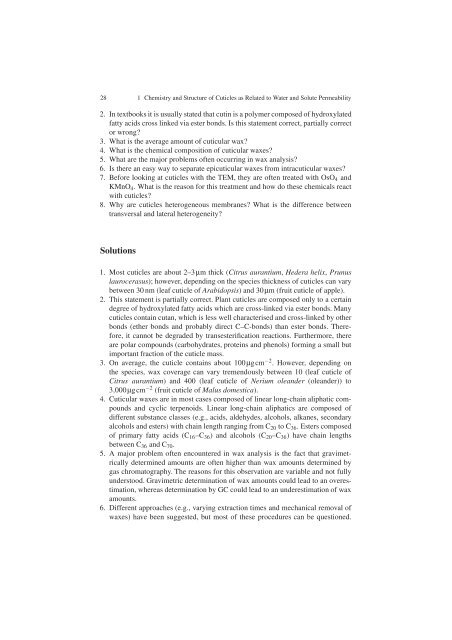Water and Solute Permeability of Plant Cuticles: Measurement and ...
Water and Solute Permeability of Plant Cuticles: Measurement and ...
Water and Solute Permeability of Plant Cuticles: Measurement and ...
You also want an ePaper? Increase the reach of your titles
YUMPU automatically turns print PDFs into web optimized ePapers that Google loves.
28 1 Chemistry <strong>and</strong> Structure <strong>of</strong> <strong>Cuticles</strong> as Related to <strong>Water</strong> <strong>and</strong> <strong>Solute</strong> <strong>Permeability</strong><br />
2. In textbooks it is usually stated that cutin is a polymer composed <strong>of</strong> hydroxylated<br />
fatty acids cross linked via ester bonds. Is this statement correct, partially correct<br />
or wrong?<br />
3. What is the average amount <strong>of</strong> cuticular wax?<br />
4. What is the chemical composition <strong>of</strong> cuticular waxes?<br />
5. What are the major problems <strong>of</strong>ten occurring in wax analysis?<br />
6. Is there an easy way to separate epicuticular waxes from intracuticular waxes?<br />
7. Before looking at cuticles with the TEM, they are <strong>of</strong>ten treated with OsO4 <strong>and</strong><br />
KMnO4. What is the reason for this treatment <strong>and</strong> how do these chemicals react<br />
with cuticles?<br />
8. Why are cuticles heterogeneous membranes? What is the difference between<br />
transversal <strong>and</strong> lateral heterogeneity?<br />
Solutions<br />
1. Most cuticles are about 2–3µm thick (Citrus aurantium, Hedera helix, Prunus<br />
laurocerasus); however, depending on the species thickness <strong>of</strong> cuticles can vary<br />
between 30 nm (leaf cuticle <strong>of</strong> Arabidopsis) <strong>and</strong> 30µm (fruit cuticle <strong>of</strong> apple).<br />
2. This statement is partially correct. <strong>Plant</strong> cuticles are composed only to a certain<br />
degree <strong>of</strong> hydroxylated fatty acids which are cross-linked via ester bonds. Many<br />
cuticles contain cutan, which is less well characterised <strong>and</strong> cross-linked by other<br />
bonds (ether bonds <strong>and</strong> probably direct C–C-bonds) than ester bonds. Therefore,<br />
it cannot be degraded by transesterification reactions. Furthermore, there<br />
are polar compounds (carbohydrates, proteins <strong>and</strong> phenols) forming a small but<br />
important fraction <strong>of</strong> the cuticle mass.<br />
3. On average, the cuticle contains about 100µgcm −2 . However, depending on<br />
the species, wax coverage can vary tremendously between 10 (leaf cuticle <strong>of</strong><br />
Citrus aurantium) <strong>and</strong> 400 (leaf cuticle <strong>of</strong> Nerium ole<strong>and</strong>er (ole<strong>and</strong>er)) to<br />
3,000µgcm −2 (fruit cuticle <strong>of</strong> Malus domestica).<br />
4. Cuticular waxes are in most cases composed <strong>of</strong> linear long-chain aliphatic compounds<br />
<strong>and</strong> cyclic terpenoids. Linear long-chain aliphatics are composed <strong>of</strong><br />
different substance classes (e.g., acids, aldehydes, alcohols, alkanes, secondary<br />
alcohols <strong>and</strong> esters) with chain length ranging from C20 to C36. Esters composed<br />
<strong>of</strong> primary fatty acids (C16–C36) <strong>and</strong> alcohols (C20–C36) have chain lengths<br />
between C36 <strong>and</strong> C70.<br />
5. A major problem <strong>of</strong>ten encountered in wax analysis is the fact that gravimetrically<br />
determined amounts are <strong>of</strong>ten higher than wax amounts determined by<br />
gas chromatography. The reasons for this observation are variable <strong>and</strong> not fully<br />
understood. Gravimetric determination <strong>of</strong> wax amounts could lead to an overestimation,<br />
whereas determination by GC could lead to an underestimation <strong>of</strong> wax<br />
amounts.<br />
6. Different approaches (e.g., varying extraction times <strong>and</strong> mechanical removal <strong>of</strong><br />
waxes) have been suggested, but most <strong>of</strong> these procedures can be questioned.







